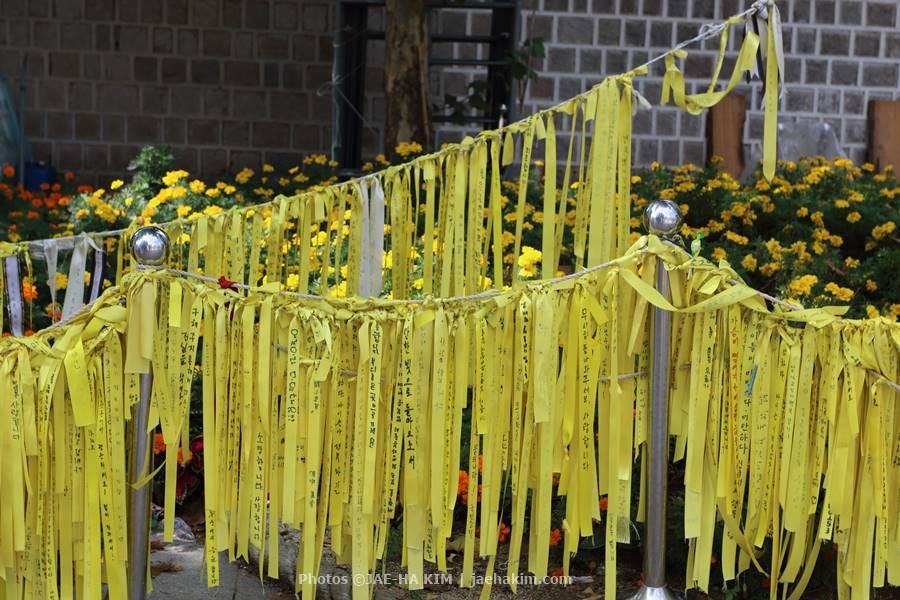Was Korean culture to blame for the Sewol tragedy?
This was the shamefully racist question U.S. news organizations asked
Nine years ago, I wrote the following essay after the Sewol Ferry capsized on April 16, 2014. I’m sharing it with you on the anniversary of this tragic day.
More than 300 passengers — the majority of them students and faculty members of the Danwon High School in South Korea — are dead or missing after the Sewol ferry crashed and sank on April 16. Since then, media coverage has been intense, focusing on the cowardly and criminal act of the captain — who literally jumped ship — and eulogizing the brave young crew members who risked their own lives (and died), while tending to the passengers.
But because that's just not compelling enough, the news has taken another approach, questioning whether Korean culture is to blame for the deaths.
That's right. Let's blame culture.
Ralph De La Cruz of the Dallas Morning News wrote:
Here in the United States, it’s hard to imagine that, first of all, a bunch of high school kids would even listen, much less totally and faithfully comply with an adult’s instructions – even as a ship sinks.
That’s because we Americans – and certainly Texans – value the individual over the group. If that was a boatload of American students, you know they would have been finding any and every way to get off that ferry. But in Asian cultures, which place the needs of the group over the needs of the individual, compliance is de rigueur.
So, you end up with this horrendous death by obedience.
And Kyung Lah — who I used watch on the evening news in Chicago — did this report for CNN:
Cultural values in South Korea possibly played a role in why so many people remained below deck when a ferry sank off the coast of South Korea, an accident that killed 29 people and left nearly 270 missing.
The questioning of culture in situations like this is an easy way out. It's a way of "reporting" news to people who know little about other cultures and therefore won't question what has been written. Mr. De La Cruz speaks with authority about how this tragedy was "death by obedience" and how this wouldn't have happened if the passengers had been American teenagers.
He knows this how? He doesn't. He's making unqualified assumptions.
Think about the Sandy Hook Elementary shooting. The children that followed the teachers' orders and hid in the closet all survived. Yes, they were younger than the Danwon students and one could argue that elementary-age children would be more likely to be obedient than older kids.
But then what about the adults who perished in the Twin Towers during 9/11? Would more people have survived the terrorist attacks had they made the decision to escape, rather than stay put in their offices as they were advised to do? And would any of us dare blame the victims, or American culture, for their lost lives?
Announcements that the building was "secure" may have led to the deaths of hundreds of people. After American Airlines Flight 11 hit the north tower, fire safety officials for the Port Authority of New York and New Jersey, which operated the Trade Center, broadcast several announcements over the public-address system that the south tower was safe and that workers did not need to evacuate. Many who were leaving the south tower turned back when they heard them. (source: USA Today)
These were adults well versed in critical thinking who did as they were told, because there was no reason at the time to believe that they shouldn't.
So the question remains: When do you follow authority guidance? It seems like if you do and it works out, you're a heroic survivor. But if you do and it doesn't work, then it's your own fault for following orders.
The victims of Sewol didn't succumb to "death by obedience." They perished because the ship sank. There was chaos. The captain didn't do enough to keep his passengers safe. If the captain hadn't issued the order to remain on the ship and the students started jumping overboard, there may have been more survivors. We don't know. What we do know is that some of the students died saving the lives of others. They were told to put on their lifejackets, but some took theirs off to give them to classmates. They jumped into the water to save others. They were not lemmings. They were scared, confused children.
If passengers defied his orders and started looking for alternatives, as De La Cruz of the Dallas Morning News brags that American kids would have done, what then? If they went to the boat's tilted side looking for lifeboats, the rafts would've already been submerged in water. So were they to climb to the top of the ship and somehow try to deploy the lifeboats themselves?
The lack of crew onboard who knew what to do isn't about Korean culture. It's about greed and a company that didn't train its staff enough for emergencies. And, unfortunately, this is a universal problem.
The question of culture arose again when Danwon's vice principal Kang Min Kyu died by suicide after being rescued from the ferry. Because he had planned the excursion, he said (in his suicide note) that he felt responsible for the children's deaths. Some reporters theorized that this was normal in Asian culture when you've lost face. I'm not going to argue that suicide isn't a problem in Korea.
But then in the same articles, they mention disgraced captain, Lee Joon-seok — who clearly is still alive. Why would culture affect one man but not the other? Could individualism possibly have something to do with how each man reacted to the tragedy?
The Western media has a tendency to fixate on whether culture was part of the problem when things happen in Asia. Like there's some ancient Chinese secret that Asians utilize at will.
In his New York Times bestseller "Outliers," Malcolm Gladwell theorizes that Korean culture was largely to blame for Korean Air's 1997 crash. When Asiana (another Korean airline) crashed in 2013, many reporters quoted Gladwell and his book to again point the finger at Korean culture.
Ask A Korean took apart Gladwell's theory in his excellent blog post here. What AAK says about culture and culturalism holds true with the Sewol tragedy as well:
The danger of culturalism is made plain. Culturalism may not be the same thing as racism, but they share the same parent: the instinct to connect race or ethnicity to some kind of indelible essence. Because culturalism and racism are two streams from the same source, the harms caused by culturalism are remarkably similar to those caused by racism.
Like racism, culturalism puts a large group of people beyond rational understanding. No sane person would be willing to die for the sake of keeping up with manners — yet that is precisely what Malcolm Gladwell would have you believe about the 75 million Koreans around the world.
We don't know all the details about the Sewol tragedy yet. But, ask yourself this: What do you think your 15-year-old son or daughter would've done in this situation? Would they have defied a Captain's order and jumped overboard into icy cold water? Or does it seem more likely that — like most children worldwide — they would have assumed that the Captain knew what he was doing? At the time, they had no reason to believe that the ferry would sink as quickly as it did or that they were in imminent danger.
When my husband and I took a cruise a decade or so ago, we sailed through Indonesia's seas — which have been described as the world's most dangerous waters. There were two times when the passengers were warned to return to their cabins, lock the doors and remain there until further notice. One time was because there were pirates surrounding the ship.
I was born in Korea and spent my early years in Seoul. My husband was born and raised in the United States. We were adults who weren't afraid to question authority and we both reacted the same way: We went into our cabin, locked our door and remained there until further notice. Which, we found out later, is what the rest of the passengers — almost all of whom were American or European adults — did, too.
The Sewol tragedy was horrific.
Shame on those who are second guessing the actions of the panicked young victims who did the best that they could in a frightening situation.
While BTS has never confirmed that “Spring Day” is about the Sewol tragedy, the Korean group has alluded to it in interviews. And many fans and music critics — including myself — believe it to be true as well.
Note: Both the photos are from a trip we took to South Korea in October 2014. As you can see, there were yellow ribbons memorializing the victims. In the second photo, our young son was running around trying to count all the ribbons. It broke my heart that he had to count so high.
© JAE-HA KIM | All Rights Reserved






SHAMEFUL! The audacity to say *anything* when we can't even keep our children from fearing being shot in schools. They've clearly never seen the continued mourning. They've never been in Korea to witness it, not even once. There's no way they'd have said such crap if they could see it since they obviously refuse human compassion.
One of the most heartbreaking things I saw in my one visit to Seoul were loved ones of a student missing in the tragedy, asking for help to find her. It was a year and a half since the sinking.
Of course, Western media would like to point at tragedies like this and say "not us!" I felt the same way when watching how American media covered the so-called "war on drugs" in my home country, the Philippines, 'waged' by former president Duterte and resulting in the deaths of thousands of users, but none of those involved in the selling.
The coverage was a lot of "see, at least our country hasn't devolved into this" -- I guess they needed to feel good since Trump was doing his horror on the US, but constantly pointing out (not inaccurately) that this was a policy of a president a plurality of the country voted for, and suggesting the whole country wanted it (not really, no)...
...sigh.